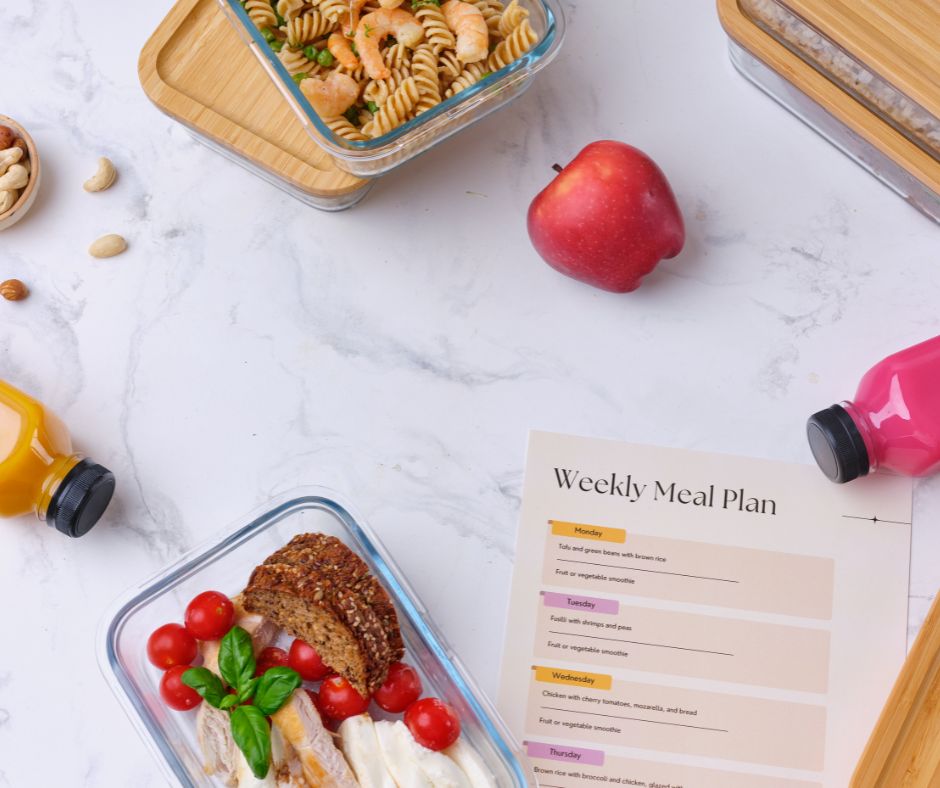How to Stop Emotional Eating: 7 Practical Tips to Break the Cycle
Balancing a demanding career, managing family responsibilities, and trying to carve out time for self-care is a massive task for many women today. It’s no wonder that emotional eating – using food to cope with stress, fatigue, or even boredom – is a common struggle. Emotional eating often serves as a temporary escape, but it can sabotage weight loss efforts, drain energy, and leave you feeling worse than before.
If you’re tired of feeling stuck in the cycle of emotional eating and want to regain control over your relationship with food, you’re in the right place. In this blog post, we’ll explore the roots of emotional eating and provide seven practical strategies to help you stop emotional eating, improve your well-being, and create healthier habits.

What is Emotional Eating?
Emotional eating happens when food becomes a way to manage emotions rather than to satisfy hunger. For many women, this is a deeply ingrained coping mechanism, often developed over years of stressful life experiences. Whether it’s reaching for chocolate after a tough meeting, snacking in front of the TV to unwind after the kids are in bed, or eating out of sheer boredom, emotional eating has become a familiar pattern for many.
While emotional eating may offer temporary relief, it typically leads to feelings of guilt, frustration, and even more stress – which can perpetuate the cycle. Worse still, it often involves high-sugar, high-fat, and highly processed foods that wreak havoc on your health.
How Can I Tell If I’m an Emotional Eater?
Before we dive into how to stop emotional eating, it’s important to understand whether you might be falling into this pattern. Here are some common signs:
- Eating becomes a way to calm down after a stressful day or during difficult situations.
- Turning to food happens even when the body doesn’t actually need fuel.
- Cravings for comfort foods, often unhealthy options like sweets, crisps, or fast food, are common.
- Once eating begins, it can feel uncontrollable, even when fullness is reached.
- Feelings of guilt or shame often follow, leading to regret after emotional eating.
Why Do We Emotionally Eat?
The triggers for emotional eating can vary from person to person, but they typically fall into several key categories:
- Stress: The pressures of daily life can lead to chronic stress, which increases levels of cortisol, a hormone that makes you crave sugary, fatty foods. Many women use food as a quick fix to calm down after a long day or difficult moment.
- Fatigue: Busy professional women, particularly mothers, often find themselves physically and mentally drained. Emotional eating becomes a way to deal with fatigue – a quick energy boost through food, especially sugary snacks, can feel like the easiest option.
- Emotional Void: Sometimes, women turn to food when they feel bored, lonely, or unsatisfied. It’s an attempt to fill an emotional gap, but food never truly addresses the underlying issue.
- Reward: Many women use food as a way to reward themselves for hard work, like having a treat after getting through a hectic day. While the intention may seem harmless, using food as a reward can reinforce unhealthy eating habits.
How to Stop Emotional Eating: 7 Practical Tips to Break the Cycle
The good news is that emotional eating is a habit, and like any habit, it can be changed. Here are seven actionable strategies that can help you stop emotional eating and regain control over your eating habits and emotions.
1. Identify Your Triggers
The first step to breaking the emotional eating cycle is awareness. Start by identifying what triggers your emotional eating. Is it stress from work? Family responsibilities? Or maybe it’s something deeper, like feelings of inadequacy or boredom?
Action Step: Keep a food journal for a week. Write down what you eat, when you eat, and how you’re feeling at the time. This will help you pinpoint emotional eating triggers so you can address the root cause.
2. Find Healthier Ways to Cope with Stress
Once you’ve identified your emotional eating triggers, it’s important to find healthier alternatives for managing those emotions. This might involve creating new self-care habits or learning how to better manage stress.
Ideas to Try:
- Exercise: Physical activity is a proven stress reliever. Even a quick 10-minute walk can release endorphins and improve your mood.
- Meditation: Practising mindfulness or deep breathing exercises can help you stay present and break the habit of turning to food when you’re stressed.
- Hobbies: Take time to engage in activities you love, such as reading, painting, or gardening. This can help you relax and reduce emotional eating triggers.
3. Practice Mindful Eating
Mindful eating is about paying attention to what and how you’re eating. It involves eating slowly, savouring your food, and recognising when you’re full. This can help you differentiate between physical hunger and emotional hunger.
Tips for Mindful Eating:
- Eat without distractions (e.g., avoid eating in front of the TV).
- Chew slowly and savour each bite.
- Pause between bites to give your body time to signal when it’s full.
4. Build a Strong Support System
Many busy women struggle with feeling isolated or unsupported, which can contribute to emotional eating. Building a strong support network can make a huge difference.
Action Step: Reach out to friends, family, or a community of like-minded women who understand your challenges. Consider joining an online support group for women who are working on emotional eating or overall wellness. Having someone to talk to can ease stress and reduce the urge to use food as an emotional crutch.
5. Get Enough Sleep
Sleep deprivation is a common issue among women who juggle work and family, and it’s a major contributor to emotional eating. Lack of sleep not only increases hunger hormones like ghrelin but also decreases your ability to make healthy food choices.
Action Step: Aim for 7-8 hours of sleep each night. Create a bedtime routine that helps you wind down, such as reading, taking a warm bath, or practising meditation.
6. Meal Planning for Success
A lack of planning can lead to poor food choices, especially when you’re hungry or stressed. Meal planning ensures that you have nutritious, satisfying meals and snacks on hand, reducing the temptation to reach for unhealthy comfort foods when emotions run high.
Action Step: Spend time each week planning and prepping meals. Make sure to include foods that are high in protein and fibre, as these help keep you fuller for longer. Consider preparing meals in batches so that you have healthy options ready to go on even the busiest of days.
7. Seek Professional Help if Needed
If emotional eating feels overwhelming and you’re struggling to manage it on your own, seeking professional help may be the best step. A registered dietitian, therapist, or counsellor who specialises in emotional eating can offer guidance, support, and strategies tailored to your unique needs.
How to Start Breaking the Cycle Today
Breaking the cycle of emotional eating is not about willpower or deprivation – it’s about creating awareness and building healthier habits that address the root causes of your emotions. Here’s a quick summary of how to get started:
- Identify Your Triggers: Keep a journal to understand what causes emotional eating.
- Develop Coping Strategies: Find stress-relieving activities other than food.
- Practice Mindful Eating: Slow down and savour your food.
- Build a Support Network: Surround yourself with positive people who support your goals.
- Prioritise Sleep: Make sure you’re well-rested so your body can regulate hunger properly.
- Plan Your Meals: Prepare nutritious meals in advance to avoid unhealthy choices.
- Seek Help if Needed: Consider professional guidance to help you navigate your emotions and relationship with food.
FAQs About Emotional Eating
1. Why do I eat when I’m not hungry? Many people eat when they aren’t hungry due to emotional triggers, such as stress, boredom, or sadness. This is known as emotional eating, where food is used to manage emotions rather than to satisfy hunger.
2. How do I know if I’m an emotional eater? If you often turn to food for comfort or stress relief, eat when you’re not hungry, or feel guilty after eating, you may be engaging in emotional eating.
3. Can emotional eating be cured? While emotional eating is a deeply ingrained habit, it can be managed and reduced through mindfulness, self-awareness, and healthier coping strategies.
4. What should I eat when I feel stressed? Instead of reaching for high-sugar or high-fat comfort foods, try eating healthy snacks rich in protein or fibre, such as nuts, fruits, or yoghurt. Also, consider stress-relief methods like meditation, exercise, or talking to a friend.
Bottom Line
Emotional eating is a common struggle, but it doesn’t have to control your life. By learning to identify your triggers, practising mindful eating, and building healthier coping mechanisms, you can stop emotional eating and achieve your health goals. Remember, it’s a journey, not a quick fix – be kind to yourself and celebrate your progress along the way.
Your body deserves to be nourished, not just fed.
If you’re struggling with emotional eating, get in touch and we can have a free chat.
You might also like …
5 Reasons Why Stress Sabotages Your Weight Loss Efforts
How stress impacts your weight and what you can do to help. Feeling constantly tired, craving sugar, and noticing stubborn belly…
Unlock More Energy With Better Gut Health
Why Your Gut Might Be the Missing Link in How You Feel You’re juggling a million things—work deadlines, family logistics, hormonal ups…
The Best Brain-Boosting Foods for Focus and Clarity
The Best Brain-Boosting Foods for Focus and Clarity Do you ever find yourself struggling to focus during a busy day, forgetting…
7 Quick and Powerful Mood Boosters for Busy, Stressful Workdays
Quick Ways to Boost Your Mood Naturally During a Busy Day When was the last time you felt truly energised during…
What to eat when you have no time to cook
What to Eat When You Have No Time, Energy & Motivation Feeling shattered and unmotivated? After a busy, long day you…
Expert Tips for Weight Loss That Actually Work
Expert Tips for Weight Loss That Actually Work Weight loss can often feel like an uphill battle, especially with so much…






